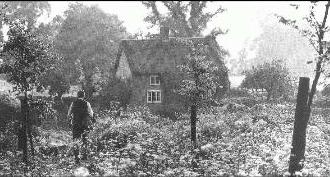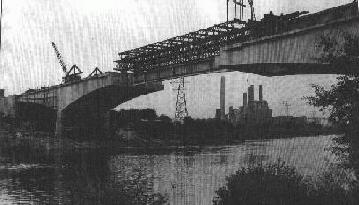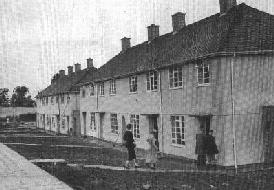| |
These pages were produced by Roy Mat for his Wilford & Clifton
Index in 1997
|
|

|
|
The Glapton
Area Of Clifton Before The Housing Developments
|
|
Background
Clifton is recorded in William The Conquerors Doomsday book as 'Clifton-cum-Glapton'.
Glapton was a much smaller village neighboring Clifton, eventually to be
absorbed by Clifton. Clifton's name probably arises from the Cliff
on which the community overlooks the Trent. In the 19th century,
Clifton was viewed as the perfect English village, with its thatched houses,
green meadows, extensive woodland and its's small traditional population.
|
| The 'Close' Village
Clifton was always a 'close' village prior to
the 20th Century - a village managed at every level by the holders of the
manor house, in this case the Clifton
Family . This meant that all the residents, their occupations
and the buildings they lived and worked in were entirely subject to the
Clifton's approval. The Clifton's appear to have followed a policy
of retaining a static population. The number of people living in
the area hardly changed at all throughout hundreds of years. For
example in 1801 381 people lived in Clifton and a century later the number
had risen to just 383! As children in the area grew older they were
ultimatley forced to leavein search of work and places to live. Many
left for nearby villages or the growing Nottingham. In contrast to
Clifton, the population of the nearby 'open' village of Ruddington grew
to three times its size over the same hundred year period.
Development As A Housing Estate
In 1947 the Nottigham City Council actioned a compulsary purchase on
a large portion of Clifton land. Nine hundred acres were bought for
£83,000. The purchase was prompted by Nottingham's servere
housing shortage. The council had a waiting list of 10,500 people!
The sudden demand was a due to a combination of the demobilization of servicemen
and women from the second world war and slum clearamce initiatives..
In late 1945 the city council recommended a compulsory purchase order to
buy over 900 acres of land from the Clifton estate for housing.
There was much heated debate over the future of Clifton between some of
the City Council and the County Council representatives with opposition
from the Basford District Council and the National farmers Union before
the project was finally approved. The owner of the land at that time
was Colonel Peter Clifton. He agreed to sell the land and the compulsory
purchase was never served. |
 |
|
The Construction Of Clifton Bridge
|
|
As the estate grew over the following years
the locals
always objected fruitlessly to the loss of the areas natural beauty.
Even the support of organizations such as
the Preservation Of Rural England and the Ramblers Association had
little or no effect on the outcome. By 1953 the population had rocketed
from 383 in 1901 to 6,000 people living in 1,838 houses. The increased
population resulted in more traffic crossing over Trent Bridge into Nottingham.
It soon became apparent a new bridge would need to relieve the pressure.
The Clifton bridge was constructed in 1955 spanning the Trent between Clifton
and Wilford close to the original entrance to Clifton
Grove .
|
| The 1950's In Clifton - 'Hell On Earth'
Clifton was to become no stranger to protests, bitter divisions and
controversy. Residents complained about the lack of facilities such
as shops and places of entertainment to accommodate the massive insurge
of new people. The site was so large uniform and depressing in its
design that a community spirit failed to materialize. The focal point
for the criticisms came from a program broadcast in 1958 which profiled
the estate as a 'hell on earth' and a 'soul-less, heartless dormitory'.
The chairman of the Nottingham Education Committee labeled the program
'Paper Talk' as a 'distorted' view. n the Guardian Journal on the
21/2/1958 he was reported as saying 'The estate was alleged to be a
wilderness of concrete ... with a complete absence of facilities for children
... parks, youth clubs, playing fields, gymnasia, dance hall, cinema, coffee
bars etc'. |

|
|
New Clifton Houses In
1951
|
|
In the Guardian Journal on the 21/2/1958 he was reported as saying 'The
estate was alleged to be a wilderness of concrete ... with a complete absence
of facilities for children ... parks, youth clubs, playing fields, gymnasia,
dance hall, cinema, coffee bars etc'. He went on to advocate
the Clifton Youth Club and the efforts of the areas churchs which had not
been represented in the program. The journalist responsible for the
report was surprisingly, later sacked indicating he was found to have unfairly
presented Clifton. The estate however was a regular feature
in the Nottingham papers throughout the sixties and seventies with the
same issues recurring over and over again. The lack of facilities, the
drabness and the lack of community spirit.
By 1958 the entire Clifton area had been bought from the Clifton's.
It was then the largest housing estate in Europe.
Post 1950's Clifton
In 1967, Mrs Wendy Godfrey conducted a survey to find out once and for
all how the people of Clifton really felt about the estate. She polled
1 house in 13 and found that 76% of people were happy with the area.
Ten years later the survey might have produced different results as the
debate over the quality of life at Clifton again aroused strong feelings.
More and more houses were added to the estate, many of them low density
private houses, in a beautiful area bordering Clifton Grove.
In 1976 the residents objected to further building by pointing out that
the estate 'already suffered from inadequate social amenities' and
highlighted increasing 'crime rate, child problems, the size of Clifton
Estate.' A local newspaper described the situation:- 'A gloomy
picture of life on Clifton Estate was painted at the public inquiry ...
vandalisum is rife .., truancy and crime rates are rising and there is
a general lack of facilities for the community ... it is an area of major
social stress ... Clifton ... the size of a town ... had a population of
26,000 in 1971' and still the building projects continued. In
1978 the Clifton minister described the estate as a 'dormitory'
rather than a 'community'. At about the same time the
Evening Post ran an article outlining the area with 'in terms of planning
and architecture it is a monument to mediocrity. Not that it makes
it different from any other housing estate. Its just that Clifton
is ... perhaps the biggest in Europe.'
I went to see the English Comedian, Jasper Carrott, when he appeared
at the Theatre Royal in Nottingham in early 1990's. He worked
Clifton into his act. He had the day before visited a friend at a
place called 'Clifton Village. Hmm I thought. That sounds like a nice
place ( audience laughs ). When I got their I thought, strewth! Hitler
died in one of these!' Comparing some of the dreary, concrete
houses in Clifton to bunkers certainly got a favorable reaction from the
audience.
Clifton Today
In my opinion Clifton still suffers from a lack of facilities.
Attempts have been made to sort this out. There are now plenty of
shops. A swimming pool has been around in Clifton since the late
sixties and it has recently branched out with facilities for tennis and
badminton. I still think the sites activities appear a bit limited. The
Sun Valley amusement block was opened about the same time but was never
really anything more than a slot machine arcade and bar. As
a child growing up in the area I felt the best form of Clifton entertainment
in the seventies and early eighties was a small two screen cinema.
It was attached to the Sun Valley building. It showed all the popular
films of the day and charged a third of the admittance fee required by
the big cinemas in Nottingham. It was always busy and I was quite
surprised and disappointed when it closed in around 1985. Its true
there are now a few pubs in Clifton but somehow all of this has left little
for kids to participate in. Clifton deserves a fully fledged Leisure Centre
catering for all manor of sports.
The houses are not as gray and uniform as they were twenty years ago.
There is more colour and variety about the houses which many of the occupants
have bought them from the Council. The old parts of Clifton village
still retain much of the locations original charm with plenty of picturesque
cottages and old buildings. The necessities of urgently required
houses in the forties and fifties inevitably led to problems on the estate
but I think it was a mistake to build more houses in the late sixties and
seventies on very attractive land after the post war demand had long since
been satisfied.




